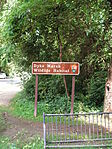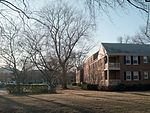Fort Foote
1863 establishments in MarylandAmerican Civil War fortsAmerican Civil War on the National Register of Historic PlacesCivil War defenses of Washington, D.C.Forts in Maryland ... and 6 more
Forts on the National Register of Historic Places in MarylandNational Capital Parks-EastNational Park Service areas in MarylandNational Register of Historic Places in Prince George's County, MarylandParks in Prince George's County, MarylandUse mdy dates from February 2020

Fort Foote was an American Civil War-era wood and earthwork fort that was part of the wartime defenses of Washington, D.C., which helped defend the Potomac River approach to the city. It operated from 1863 to 1878, when the post was abandoned, and was used briefly during the First and Second World Wars. The remnants of the fort are located in Fort Foote Park, which is maintained by the National Park Service as part of the National Capital Parks-East system. The area's mailing address is Fort Washington, Maryland.
Excerpt from the Wikipedia article Fort Foote (License: CC BY-SA 3.0, Authors, Images).Fort Foote
Fort Foote Trail,
Geographical coordinates (GPS) Address Nearby Places Show on map
Geographical coordinates (GPS)
| Latitude | Longitude |
|---|---|
| N 38.7666667 ° | E -77.0277778 ° |
Address
Fort Foote Trail
23242
Maryland, United States
Open on Google Maps










